A case study in the management of reality
Francisco Gil-White | The Management of Reality | Nov 04, 2024
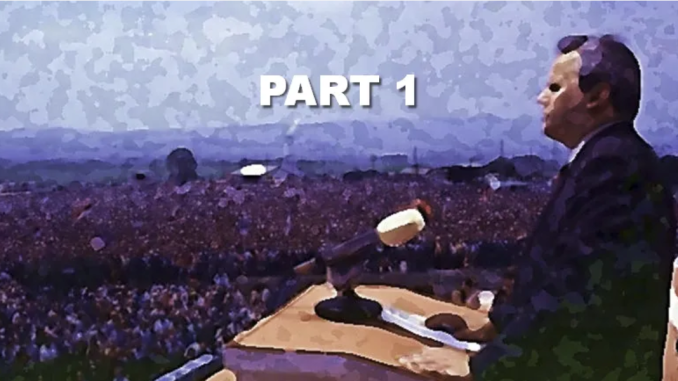
- It’s good that Mat Walsh and Konstanin Kisin, at the top of their game and with large audiences, have ridiculed the media for painting Donald Trump’s recent event at Madison Square Garden as a ‘Nazi rally.’
- We didn’t have Walsh and Kisin back in the 1990s, before the blog and podcast revolutions, when the media did the same with Slobodan Milosevic’s famous 1989 speech in Kosovo, which was the precise opposite of a ‘Nazi rally.’
- It pays to understand how we were lied to about Milosevic’s speech, and Yugoslavia more generally, for here lies a historical key to unlock the political and geopolitical structure of the Western world.
- If you understand Western policy in Yugoslavia, you will understand Western policy in the Middle East.
Introduction
Yugoslavia was a country in southern Europe composed of many ethnicities: Serbs, Croats, Bosnian Muslims, Hungarians, Slovenes, Kosovo Albanians, Montenegrins, Macedonians…. Armed conflict broke out between Serbs, Croats, and Muslims in the 1990s and those civil wars tore Yugoslavia apart. In the mass communications of our Western governments, established universities, mainstream media, and leftist NGOs, a consensus narrative was established about these civil wars: it was all the fault, they told us, of the Serbs.
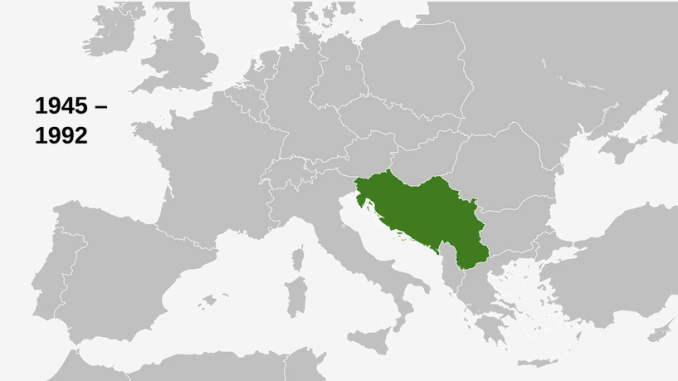 Yugoslavia was a large country (by European standards) in the Balkans that was destroyed by civil war in the 1990s. Image credit: Wikipedia.
Yugoslavia was a large country (by European standards) in the Balkans that was destroyed by civil war in the 1990s. Image credit: Wikipedia.
Some true elements of Yugoslav history were recruited and weaved with many lies and fabrications in order to support this mainstream NATO, media, academic, and NGO narrative, which went something like this.
In the Middle Ages, the Orthodox Christian Serbs, supported by Orthodox Byzantium, fought medieval religious wars with the Catholic Croats, themselves supported by the papacy and the Catholic Kingdom of Hungary. Then, from the East, came charging the Ottoman Turkish Muslims. When the Serbian Prince Lazar and the united Serbs failed to secure a decisive victory at the famous Battle of Kosovo in 1389, there followed 500 years of oppression for the Serbs under the Ottomans and their local allies: the Bosnian and Albanian Muslims. As a result of this history, ethnoreligious hatreds became a permanent aspect of Balkan culture (from which the term ‘Balkanization’). Such hatreds flared up most violently during World War II, when fascist Croats, and jihadi Muslims, Bosnian and Albanian, allied with the German Nazis against the Serbs. But, after the war, Marshall Josip Broz Tito, the Yugoslav communist strongman, kept those hatreds contained. After Tito died in 1980, however, keeping the peace in the Serbian province of Kosovo between Serbs and Albanians became increasingly difficult. Then, in 1989, on the 600th anniversary of the medieval Battle of Kosovo between the Christian Serbs and the Muslim Ottomans, Slobodan Milosevic—an ethnic Serb and president of Yugoslavia and Serbia—recruited the symbolism of that battle, according to this story, to ignite a revanchist and genocidal anti-Muslim Serbian nationalism. He did this, they said, in a speech delivered before (perhaps) two-million Serbs gathered at the very site of the battle, in the Field of Blackbirds, Kosovo Polje (Gazimentan). Mind you, the media incessantly called Milosevic the “new Hitler” and the Serbs the “new Nazis,” so you were supposed to conjure in your mind the famous images of German Nazi rallies with the Führer foaming at the mouth and the bloodthirsty troops hailing his racist diatribes. Milosevic’s alleged racist aggression against Kosovo Muslims, according to this narrative, had made other Yugoslav ethnicities—especially the Croats and Bosnian Muslims—nervous. When these latter communities launched self-defense secessionist movements to separate from Yugoslavia, they told us, the Serbs responded with genocidal wars.
And that’s the narrative.
The targets of this narrative were poorly informed and well-meaning Westerners (such as myself), who, upon hearing of the supposed Serbian-led genocide, concluded that the NATO bombing of the Serbs and the breakup of Yugoslavia were moral imperatives. A NATO intervention was needed, they told us, to protect innocent Croat, Bosnian Muslim, and Kosovo Muslim civilians. We were asked to remember the WWII Holocaust against the European Jews and to support NATO’s effort to stop another crime like that from happening again in Europe. We believed what they told us because we didn’t know much at all about Yugoslavia or about the Serbs. Many Westerners couldn’t even find Yugoslavia on the map.
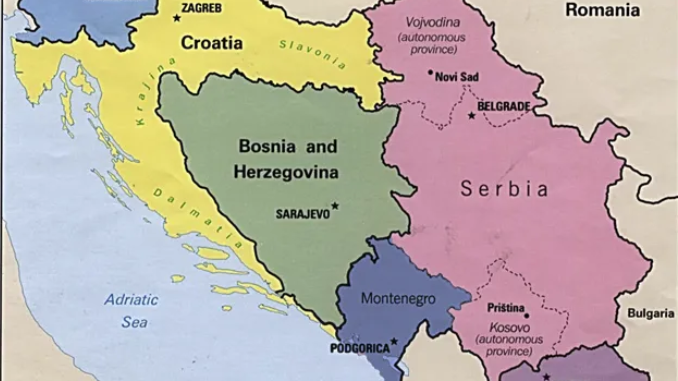 The former Yugoslavia. The Serbian Yugoslav republic had two autonomous provinces: Vojvodina in the north, and Kosovo in the south.
The former Yugoslavia. The Serbian Yugoslav republic had two autonomous provinces: Vojvodina in the north, and Kosovo in the south.
If we had known about the history of Yugoslavia, and particularly the history of the Serbs, we would have suspected immediately that the media was lying, and that two million Serbs couldn’t possibly gather in Kosovo with their leader for a ‘Nazi rally.’
Milosevic’s 1989 speech was the very antithesis of an ultranationalist racist speech. In it he recalled that the Serbs had only ever freed others and had never oppressed anyone, and he exhorted his fellow Serbs to remain true to this tradition, and to lead all Yugoslavs toward unity and brotherhood.
“… the Serbs have never in the whole of their history conquered and exploited others. Their national and historical being has been liberational throughout the whole of history and through two world wars, as it is today. They liberated themselves and when they could they also helped others to liberate themselves. The fact that in the region [Yugoslavia] they are in the majority is not a Serbian sin or shame; this is an advantage which they have not used against others. But I must say it here, in this big, legendary field of Kosovo: the Serbs have not used the advantage of being in a majority for their own benefit either.
(…)
This world is more and more marked by national tolerance, national cooperation, and even national equality. The modern economic and technological, as well as political and cultural development, has guided various peoples toward each other, has made them interdependent and increasingly has made them equal as well [medjusobno ravnopravni]. Equal and united people can above all become a part of the civilization toward which mankind is moving. If we cannot be at the head of the column leading to such a civilization, there is certainly no need for us to be at is tail.”
You can confirm this for yourself by reading either the US government translation of the speech, which Jared Israel, editor of Emperor’s Clothes, reproduced, or else the BBC’s translation:
Mind you, neither the US government nor the BBC made their translations loudly public, even as both institutions put their lies about the speech front and center in press conferences, speeches, articles, and news shows.
There is a great deal to refute in the official NATO and media narrative about Yugoslavia. But my focus in this brief five-part series will be on this key accusation, concerning Milosevic’s 1989 speech, because this event was identified as the supposed genesis of the Yugoslav civil wars of the 1990s. Milosevic’s speech, as we will see, is almost the whole game. Because, think about it. If Milosevic had really been the “new Hitler” and the Serbs the “new Nazis,” why lie about a tolerant speech to make that case? Why not use a truly racist speech, if it existed?
With the text of Milosevic’s speech in hand, I will show you in Part 5 what NATO officials, Big Media, Western academics, and Western NGOs said about it, comparing to what is actually in the speech. This will shock you.
But first, in Parts 1 through 4, I will give you the brief historical context needed to understand the accusations against the Serbs, and in particular the lies about Milosevic’s 1989 speech. This will be its own eye-opener—I promise.
The dhimma
In the Middle Ages, the Ottoman Turks conquered the Balkans in jihad and turned non-Muslims—Christian Serbs, Balkan Jews, and Roma (Gypsies)—into dhimmis: persons forced upon pain of death to accept the Islamic contract of the dhimma.
The dhimma imposes all sorts of legal disabilities on conquered non-Muslim subjects, especially in their interactions with Muslims. It effectively turns non-Muslims into a kind of slave. This unrelenting jihadi oppression was so unbearable that there were periodic Serbian uprisings against the Ottomans.1
Dhimmis were subject to arbitrary land confiscations and forced labor. Any minute, your person could be commandeered for the Ottoman State and you’d be made to work for no pay. Or the State could steal your property if it wished.
In addition, the Serbian dhimmis had to pay a special tax called the jizya. According to Islamic juristic tradition, the collection of jizya must involve slapping the payer on the neck, pulling on their beards, and/or forcing them to bow during the payment so that everyone can be reminded who is the slave and who the master. These legally required physical humiliations were sometimes followed to the letter by Ottoman officials, though the degree to which dhimmis were publicly degraded on payday varied in different times and places.
Ottoman regulations sometimes mandated that dhimmis wear distinctive hats, sashes, or other clothing items to ensure that non-Muslims were immediately recognizable, making it possible to enforce the various humiliations required in the Sharia or Islamic law. For example, dhimmis were expected to show deference to the ‘master’ Muslim population in public spaces, including yielding the right of way to Muslims and showing other signs of abasement, respect, or subordination.
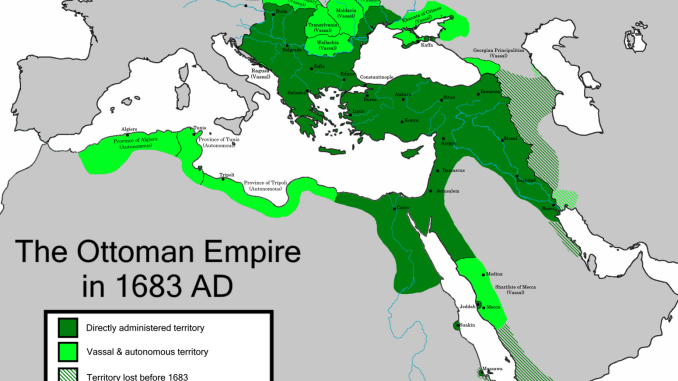 Ottoman Empire. (Image credit: Wikipedia.)
Ottoman Empire. (Image credit: Wikipedia.)
Additionally, dhimmis were generally not allowed to build new houses of worship, such as churches or synagogues, without special permission from the authorities (rarely given). Even renovations or repairs to existing structures often required a difficult-to-obtain official approval. To emphasize their inferior status, no dhimmi houses of worship could match or exceed in height any nearby mosques. And the exterior appearance of churches and synagogues had to be modest to avoid overshadowing Muslim religious sites. Dhimmis, moroever, were obligated to worship quietly and invisibly.
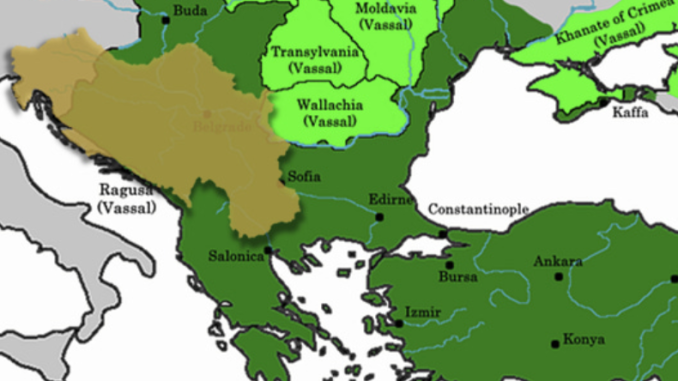 In this image, the modern Yugoslavia is superimposed on the Ottoman territories, to make clear that most of Yugoslavia was composed of territories formerly under Ottoman rule.
In this image, the modern Yugoslavia is superimposed on the Ottoman territories, to make clear that most of Yugoslavia was composed of territories formerly under Ottoman rule.
Nothing, however, was more painful than the devshirme system, also known as the ‘blood tax,’ which involved the periodic and compulsory conscription of Christian boys into the elite Janissary corps. These boys, usually between the ages of 8 and 18, were taken from their Serbian families against their parents’ wishes and turned into elite infantry soldiers attached to the Ottoman sultan’s household. The boys were forcibly converted to Islam, trained rigorously, and educated to serve as specialized slaves in various roles within the Ottoman military and bureaucracy. This was traumatic for the Serbian Christian families, as they had no choice in the matter, and it involved the forced separation of children from their communities and culture.



A fascinating account, reinforcing what we are now learning, that NATO and the West are bad guys.